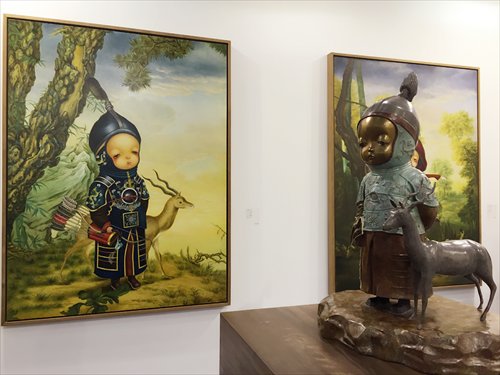Art Beijing event moves beyond sales to focus on education
 0 Comment(s)
0 Comment(s) Print
Print E-mail Global Times, May 4, 2016
E-mail Global Times, May 4, 2016
|
|
|
A painting and accompanying statue are on display at Art Beijing. (Photo: Xu Liuliu/GT) |
China, or Chinese porcelain, was one of the major stars of Art Beijing this year, as the event moved away from its traditional commercial focus. Entering its 11th year, the annual exhibition broke from previous years' aim of introducing international artworks to domestic audiences by instead shifting focus back to home, according to a report on Beijing Daily.
Held at the National Agriculture Exhibition Center from Saturday to Tuesday, the more than 25,000-square-meter exhibition featuring 160 art galleries and institutions was divided into four parts - the Contemporary Pavilion, Classic Pavilion, Design Pavilion and Art Park. The Contemporary Pavilion featured works from rising artists in Asia, while the Classic Pavilion exhibited artworks from the 16th to 20th centuries and the Design Pavilion offered special projects from up-and-coming designers. Meanwhile, to bring art closer to people's daily lives, the Art Park focus was on the public evolution of art trends.
Yet, the brightest light this year was the renewed focus on helping visitors get to know more about art - 25 graduates from the Central Academy of Fine Arts brought their group exhibition titled No.5 Jiaowei Hutong. Featuring numerous ceramic works, the exhibition delved into the history and current situation of contemporary art in Beijing. Ceramics also played a leading role over in the special exhibition Contemporary Ceramics, which tried to challenge visitors' ideas about what constitutes art.
A well-known art exhibition that has seen both public praise and good market sales, Art Beijing has continued to grow alongside the developing Chinese art market.
According to statistics from artnet.cn, the Chinese art market accounted for less than 1 percent of the global market in 2005, but surged to 20 percent in 2015 to become the third largest in the world. A report on the global art market by the European Fine Art Fair also notes that from 2005 to 2015, the contemporary art market in China had grown by more than 680 percent.
This developing art market has attracted a number of major art exhibitions to China. While few large-scale international art exhibitions could be found in the country 10 years ago, as of last year China is now host to almost 200 international exhibitions. For instance, Art Basel came to Hong Kong in 2013, while ART021 was launched in Shanghai that same year. The following year, the West Bund exhibition also kicked off in Shanghai.
Rising competition at home has pushed Art Beijing to do more to differentiate itself. Kaneshima Takahiro, former director of Art Tokyo was invited to Beijing for this year's exhibition. Under his guidance, this year's event, which traditionally was focused more on the commercial side of the art market, struck a better balance between its roles as a channel for selling art and a platform for learning about art.
"An art activity that lacks an academic side is defective," Takahiro said in an interview with cang.com, adding that one of the goals this year was to educate viewers on art knowledge and theory, as well as encouraging new ideas.







Go to Forum >>0 Comment(s)